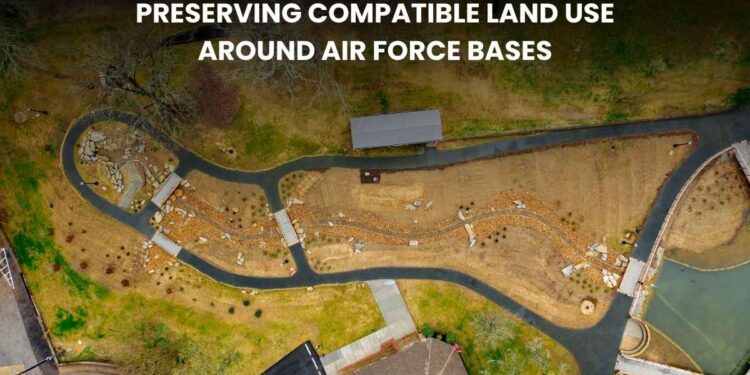The preservation of compatible land around the Air Force Base is important to ensure the safety of the community, maintain military readiness, and environmental protection. The US DoD has taken various steps to reach these goals. Let’s see the programs and policies for preservation.
The compatible land use means no risky development near flight paths, no land uses to restrict military or air force operations and training, and no noise for sensitive buildings. Hence, its preservation is highly needed to meet the community and military needs.
The US DoD uses the Air Installation Compatible Use Zone (AICUZ) programs and others for preserving compatible land use around Air Force Bases. The program finds a solution, promotes public health and safety, regulations compliance, and military needs.
What are the key programs to preserve Compatible Land around Air Force Bases?
The US Department of Defence has initiated many programs for preserving compatible land around Air Force bases, such as:
- AICUZ Programs:
- It is designed to promote development compatibility for the military operations, where land used is planned to promote public health & safety, operational capability, and development.
- The program assists the federal and state officials in reaching their goals, such as the safety and welfare of military personnel and civilians, and encourages compatible land use for smooth military and air force operations.
- The local government uses AICUZ maps and studies as guidance, raises awareness about the noise and safety around bases, promotes compatible development, and for building permits.
- Under the AICUZ, its Air Force’s responsibilities are to minimize the effects of air force operations on people, keep people aware of operations that can cause disruption, and engage in cooperative land use.
- REPI:
- The main goal of the REPO program is military readiness, hence it promotes compatible land use.
- The community partnership or cost-sharing includes all the stakeholders and ensures the use of compatible land to preserve the land around the installations.
- One of the common methods or initiatives under the REPI program is conservation easements, where the military training is supported by limiting the non-compatible land use, reducing encroachment, and installations specific to training.
- Sentinel Landscapes Partnership:
- It is an initiative under REPI that promotes collaboration between state & local government, federal agencies, and non-profit organizations to work with landowners to promote compatible land use for military installations.
- The partnership aims to increase the forestry economy, public safety, conserve natural resources, strengthen military readiness, and encourage installation resilience.
What are the factors determining compatible land for use around the Air Force base?
According to the AICUZ, the following factors are considered to determine the compatible land use around the Air Force Base:
- Noise Zones and metric:
- The AICUZ ensures the aircraft noise exposure is measured for day and night sound levels during 10 PM and 7 AM, as people are more sensitive to noise during this period.
- The AICUZ maps land based on its noise exposure to the public for determining the compatible land.
- Accidental Potential Zones:
- The Accident Potential Zones are another tool for local agencies for land planning to reduce aircraft accidents.
- The APZ marks 15000 feet from each runway end and is extended to the centreline, safer for aircraft.
- Hazardous situations:
- Another aspect considered for the compatible land is the hazardous situation of the land, such as electromagnetic interference, towers, or structures, lightning that could affect the vision of the pilot, and others.
What’s DOD’s policy for the Air Installation Compatible land?
The US DoD follows the following policies for the Air Installation compatible land use within the United States:
- Promote public health & safety: The department focuses on the public health, safety, and welfare near air installations via noise reduction, air installation safety efforts, and others.
- Encourage Compatible Land: The department promotes the use of compatible land near Air Force bases and installations. The department mandates the state and local government to follow the legislation and compatible land use in their land planning.
- Land acquisition restriction: The department promotes limited acquisition of real property interests to minimize the amount and ensure air installation integrity.
- AICUZ guidelines: The DoD ensures the AICUZ guidelines are incorporated and used for Air Force base land planning.
- Promote communication with communities: The department promotes engagement and education with communities to spread awareness of the military operations and build relationships with the community to work better for national security and public welfare.
What are the challenges in preserving compatible land use around the Air Force Base?
The DoD faced many challenges in preserving compatible land around the Air Force base that need to be addressed, such as:
- Environmental Protection: The compatible land often is places that are not used by humans, such as forests, industrial areas, agricultural lands, etc., which can affect the natural habitat, as the noise from aircraft can create problems for the wildlife too.
- Urbanization: The residential and commercial development is increasing, which is affecting the flight operations and limiting land use.
- Noise Conflicts: The aircraft produces high noise that can create problems for communities, and they can push for aircraft restrictions or others.
- Funding: The DoD’s programs need funding to achieve their goals, and they heavily rely on their partners, which sometimes can lead to a shortfall in budgets.
The compatible land use is beneficial for the air force and military, as well as for the public; however, there are many challenges as well that the US DoD is ruling out through various initiatives.











